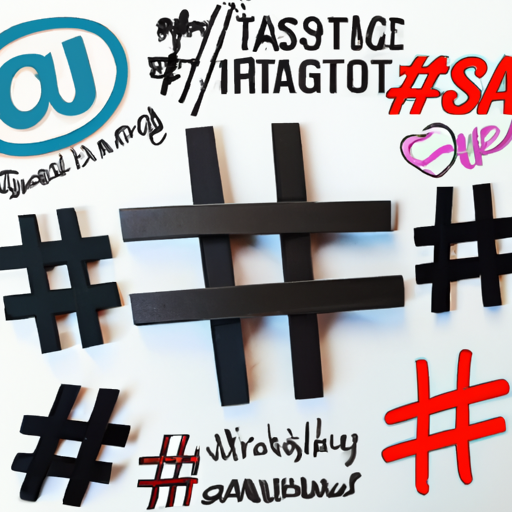In today’s digitally connected world, social media platforms have become an integral part of our daily lives. Businesses, both big and small, are utilizing these platforms to engage with their target audience, increase brand awareness, and ultimately drive sales. One effective strategy that has gained momentum in recent years is the use of hashtag campaigns. These campaigns allow companies to curate user-generated content, create a sense of community around their brand, and harness the power of social sharing. In this article, we will explore the benefits of social media hashtag campaigns and how they can be leveraged by businesses to achieve their marketing goals.
What are Social Media Hashtag Campaigns?
Social Media Hashtag Campaigns are marketing initiatives that utilize hashtags on social media platforms to promote a specific brand, product, event, or cause. Hashtags are words or phrases preceded by a pound (#) sign and are used to categorize and organize content on social media. When used strategically, hashtag campaigns can generate buzz, increase engagement, and spread brand awareness.
Definition of Social Media Hashtag Campaigns
A Social Media Hashtag Campaign is a coordinated effort to encourage users to include a specific hashtag in their social media posts related to a particular theme or topic. By using the same hashtag, users create a virtual conversation or community around that theme, making it easier to find and track related content. Hashtags enable brands to reach a wider audience and stimulate user engagement.
Importance of Social Media Hashtag Campaigns
Social Media Hashtag Campaigns play a crucial role in modern marketing strategies. They offer several benefits for businesses, including:
-
Increased Visibility and Reach: Hashtags allow your content to be discovered by users who may not be following your account, expanding your brand’s reach.
-
Enhanced Engagement: By creating a designated space for users to share their thoughts, experiences, and opinions, hashtag campaigns foster engagement with your brand.
-
Brand Awareness and Recognition: Consistently using a unique hashtag helps to establish your brand identity and make it more recognizable among your target audience.
-
User-Generated Content: Hashtag campaigns encourage users to create and share content related to your brand, increasing the volume of user-generated content and amplifying your online presence.
-
Data and Insights: By tracking and analyzing the performance of your hashtag campaigns, you can gain valuable insights into customer preferences, interests, and behaviors.
Examples of Successful Social Media Hashtag Campaigns
Several brands have executed highly successful social media hashtag campaigns. Examples include:
-
#ShareACoke by Coca-Cola: This campaign encouraged people to post pictures of Coke bottles with personalized names or phrases using the hashtag #ShareACoke. It generated massive user engagement and user-generated content, turning consumers into brand ambassadors.
-
#IceBucketChallenge by ALS Association: The Ice Bucket Challenge became a viral phenomenon on social media, raising awareness and funds for ALS (Amyotrophic Lateral Sclerosis). Participants recorded themselves pouring a bucket of ice water over their heads, shared the video using the hashtag #IceBucketChallenge, and challenged others to do the same.
-
#LikeAGirl by Always: This campaign aimed to shift the stereotype surrounding the phrase “like a girl.” Always encouraged people to share videos and pictures that redefine what it means to do something “like a girl” using the hashtag #LikeAGirl. The campaign sparked a global conversation about empowering girls and women.
How to Create a Successful Social Media Hashtag Campaign
Creating a successful social media hashtag campaign requires careful planning and execution. Here are the key steps:
Identifying Objectives and Target Audience
Before launching a hashtag campaign, it is crucial to define your objectives and identify your target audience. Determine what you want to achieve through the campaign, whether it’s increasing brand awareness, driving sales, or promoting a specific product or service. Understanding your target audience’s interests, demographics, and behaviors will help you tailor your campaign to resonate with them.
Choosing the Right Hashtag
Selecting the right hashtag is essential for the success of your campaign. Make sure it is relevant to your brand and campaign objectives, easy to remember and spell, and not already heavily used by another unrelated topic. Research existing hashtags to ensure there aren’t any negative associations or inappropriate content associated with them.
Creating Engaging and Shareable Content
Content is the backbone of any successful hashtag campaign. Create engaging, captivating, and shareable content that aligns with your brand identity and resonates with your target audience. Use high-quality visuals, videos, and compelling captions to encourage users to share your content and participate in the campaign.
Collaborating with Influencers
Influencer collaborations can significantly amplify the reach and impact of your hashtag campaign. Identify influencers within your industry or niche who have a large following and engage with their audience. By partnering with influencers, you can tap into their existing community and increase the visibility of your campaign.
Promoting the Campaign
To maximize the reach of your hashtag campaign, promote it across various channels. Leverage your brand’s social media accounts, website, email newsletters, and other marketing channels to spread the word about your campaign. Encourage employees, partners, and loyal customers to participate and share the campaign with their networks.
Monitoring and Analyzing Results
Once your campaign is live, closely monitor its performance and track relevant metrics. Use social media analytics tools to measure engagement, reach, and sentiment around your campaign. Analyzing the data will help you evaluate the success of your campaign and make any necessary adjustments for future initiatives.
Tips for Maximizing the Impact of Hashtag Campaigns
To ensure the success of your social media hashtag campaigns, consider the following tips:
Using Trending Hashtags
Leverage trending hashtags that are relevant to your campaign or industry. By participating in broader conversations, you can tap into existing user engagement and increase the visibility of your brand.
Encouraging User-Generated Content
Actively encourage users to create and share content related to your campaign. User-generated content not only boosts engagement but also provides authentic endorsements of your brand, further enhancing its credibility.
Interacting and Engaging with Users
Engage with users who participate in your hashtag campaign by liking, commenting, and sharing their posts. Show genuine interest in their contributions and foster a sense of community around your campaign.
Incorporating Visuals and Multimedia
Visual content tends to attract more attention and engagement on social media. Include eye-catching images, videos, and infographics in your hashtag campaign to capture the audience’s interest and encourage sharing.
Running Contests and Giveaways
Contests and giveaways are effective strategies to incentivize user participation in your hashtag campaign. Offer prizes, discounts, or exclusive experiences to users who engage with your campaign, encouraging them to share the campaign further.
Legal Considerations for Social Media Hashtag Campaigns
While social media hashtag campaigns can be powerful marketing tools, it is important to consider legal implications. Here are some key legal considerations:
Copyright and Trademark Issues
When using hashtags, ensure that they do not infringe on any copyrighted materials or trademarks. Be cautious when using branding elements or incorporating copyrighted content in your campaign. Seek legal advice to ensure compliance with intellectual property laws.
Disclosure and Compliance with FTC Regulations
Influencer partnerships and endorsements must comply with Federal Trade Commission (FTC) guidelines. Disclosure of any material connections between influencers and your brand is necessary to maintain transparency and avoid misleading consumers.
Privacy and Data Protection
As with any data collection practices, ensure that your hashtag campaign complies with applicable privacy laws and regulations. When collecting user-generated content or personal information, obtain consent and clearly communicate data handling practices.
How Hashtag Campaigns Benefit Businesses
Social media hashtag campaigns offer several benefits for businesses. Here’s how they can positively impact your brand:
Increasing Brand Awareness
Hashtag campaigns can significantly enhance brand visibility by reaching a wide audience beyond your existing followers. The viral nature of successful hashtag campaigns allows your brand to gain exposure and be shared extensively on social media platforms.
Expanding Reach and Audience Engagement
A well-executed hashtag campaign can help you reach new audiences and engage with existing ones. Engaged customers are more likely to share your content, promote your brand, and become loyal advocates.
Boosting Online Presence
A strong online presence is essential for modern businesses. Hashtag campaigns that generate user-generated content contribute to a robust online presence, as customers share positive experiences and interactions with your brand on social media.
Generating User-Generated Content
User-generated content provides an authentic and trustworthy perspective on your brand. Hashtag campaigns encourage users to create and share content, generating a valuable pool of user-generated content that can be repurposed in marketing efforts.
Promoting Products and Services
Hashtag campaigns offer an effective way to promote specific products or services. By creating a campaign that revolves around a particular offering, you can generate buzz, highlight unique features, and drive conversion.
Common Challenges in Hashtag Campaigns
While hashtag campaigns can yield significant benefits, they also come with challenges that businesses need to be aware of. Here are some common challenges:
Negative or Troll Responses
Hashtag campaigns may attract negative or troll responses. It is important to monitor and manage these responses promptly to protect your brand reputation. Responding professionally and addressing concerns transparently can help mitigate potential issues.
Lack of User Engagement
Not all hashtag campaigns may receive the desired level of user engagement. To overcome this challenge, focus on creating compelling content, engaging with users, and ensuring your campaign aligns with your target audience’s interests.
Difficulty in Tracking and Measuring Success
Measuring the success of a hashtag campaign can be challenging, particularly if you lack the necessary tracking tools and analytics. Set clear metrics and goals before launching your campaign and use analytics tools to monitor its performance.
Brand Reputation Management
Hashtag campaigns that receive significant attention and engagement may attract both positive and negative feedback. Implement strategies to effectively manage your brand reputation, promptly address concerns, and amplify positive sentiment.
Hashtag Campaigns in Different Social Media Platforms
Hashtag campaigns can be effective on various social media platforms. Here’s a look at their impact on popular platforms:
Hashtag Campaigns on Instagram
Instagram is known for its visual storytelling capabilities, making it an ideal platform for hashtag campaigns that rely on compelling visuals. Brands can leverage Instagram’s Explore page, Stories, and IGTV to reach a wider audience and increase engagement.
Hashtag Campaigns on Twitter
Twitter is synonymous with hashtags, and hashtag campaigns thrive on this platform. With its fast-moving nature and ability to spark real-time conversations, Twitter is ideal for timely campaigns and engaging with users directly.
Hashtag Campaigns on Facebook
Though hashtags are not as prominent on Facebook as on Instagram or Twitter, they can still be valuable for campaigns. Hashtags are useful on Facebook for brand promotions, event marketing, and driving discussions around specific topics.
Hashtag Campaigns on LinkedIn
LinkedIn offers a professional and business-oriented environment, making it suitable for B2B hashtag campaigns. Hashtags on LinkedIn can help increase brand visibility, reach industry professionals, and engage in thought leadership.
Best Practices for Hashtag Campaigns
To make your hashtag campaigns more effective, consider these best practices:
Researching and Analyzing Competitor Hashtags
Analyze the hashtag strategies of your competitors to gain insights into what works within your industry. Identify successful campaigns and adapt their tactics to fit your brand and objectives.
Testing and Refining Hashtags
Before launching a hashtag campaign, test its viability and impact. Conduct keyword research, monitor hashtag performance, and refine your strategy based on user engagement and feedback.
Consistency in Brand Messaging
Ensure your hashtag campaign aligns with your brand messaging and reinforces your brand identity. Consistency in voice, tone, and visual elements will help create a cohesive and recognizable campaign.
Responding to User Feedback
Engage with users who participate in your campaign by responding to their comments, questions, and feedback. This shows that you value their contributions and fosters a positive relationship with your audience.
Tracking and Measuring Metrics
Use analytics tools to track relevant metrics, such as engagement, reach, and sentiment. Regularly evaluate campaign performance and make data-driven decisions to optimize future campaigns.
Integration of Hashtag Campaigns with Overall Marketing Strategy
For maximum impact, integrate hashtag campaigns with your overall marketing strategy. Here’s how:
Aligning Hashtag Campaigns with Brand Identity
Ensure that your hashtag campaigns align with your brand identity and core values. Consistency across all marketing channels helps reinforce your brand image and strengthens brand loyalty.
Linking Hashtags to Other Marketing Channels
Include hashtags in your email marketing, website content, and offline promotions to cross-promote your campaigns and drive traffic to your social media platforms.
Using Hashtags in Cross-Promotion
Collaborate with other brands or influencers who complement your campaign objectives. Cross-promote each other’s hashtags to reach new audiences and leverage their existing community.
Monitoring the Impact on Sales and Leads
Track the impact of hashtag campaigns on sales, leads, or other key performance indicators relevant to your business. Analyze the correlation between campaign activities and conversions or revenue to measure campaign effectiveness.
FAQs about Social Media Hashtag Campaigns
Here are some frequently asked questions and brief answers about social media hashtag campaigns:
What is the purpose of using hashtags for social media campaigns?
Hashtags help categorize and organize content, making it easier to find and track related posts. They also enable brands to increase visibility, enhance engagement, and stimulate user-generated content.
How important is it to choose the right hashtag for a campaign?
Choosing the right hashtag is crucial for a successful campaign. A relevant, memorable, and unique hashtag can increase engagement, brand recognition, and reach. It enhances the campaign’s effectiveness and encourages users to participate.
Can I use popular hashtags even if they are unrelated to my business?
While using popular hashtags may increase visibility, it is generally recommended to use hashtags that are relevant to your business or campaign. Using unrelated hashtags may attract irrelevant audiences and dilute your brand message.
What are some examples of successful hashtag campaigns?
Examples of successful hashtag campaigns include Coca-Cola’s #ShareACoke, ALS Association’s #IceBucketChallenge, and Always’ #LikeAGirl. These campaigns generated massive engagement, user-generated content, and contributed to raising awareness.
Do I need legal advice before launching a hashtag campaign?
It is advisable to seek legal advice to ensure compliance with intellectual property laws, FTC regulations, and privacy regulations. Legal professionals can guide you on trademark issues, disclosure requirements, and data protection practices.







